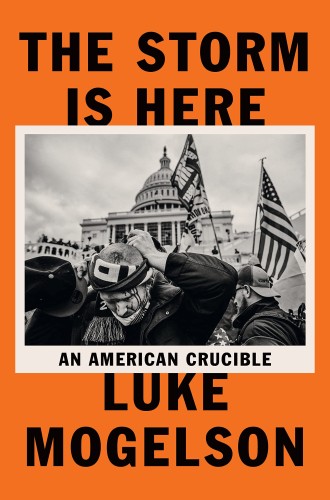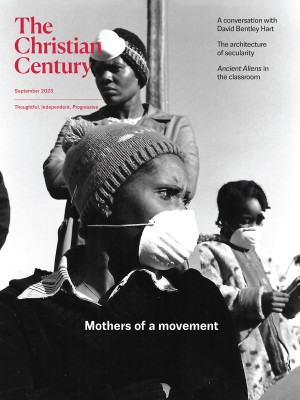A war correspondent’s view of conflict in the US
Luke Mogelson turns his keen powers of observation on the worsening polarization in this country.
To say that the United States is polarized politically is an understatement. A 2014 survey by political scientists Shanto Iyengar and Sean Westwood found that 33 percent of Democrats and 40 percent of Republicans would be “disturbed” if their child married someone from the opposite political party, compared to 5 percent in the 1960s. The 2020 election further exacerbated the divide. In The Storm Is Here, Luke Mogelson, a journalist who covered the wars in Afghanistan, Iraq, and Syria, turns his keen powers of observation on the worsening polarization in this country.
From the anti-lockdown protests that broke out in spring 2020 to the racial justice protests that followed George Floyd’s murder to the storming of the US Capitol on January 6, 2021, Mogelson embeds himself with his fellow Americans, offering a stark eyewitness account of these key events. He introduces us to a compelling cast of characters, including Karl Manke, a 77-year-old barber in Michigan who defied the statewide shutdown order; Michael Lynn Jr., a firefighter who faced increasing racism as 2020 wore on; and Felix, an amiable veteran turned ranch hand in Murdock, Minnesota, who saw no possible connection between the Trump flag hanging from his small house and the White supremacist church next door.
Read our latest issue or browse back issues.
These people, and many others spanning political lines, share what Mogelson describes as “a diminished faith in the government as a reliable authority, whether to administer justice or to ensure their safety. One emotional feature of contemporary conflict is the ever-present, low-frequency dread of the random catastrophe. . . . When no place is immune from haphazard demolition, more abstract structures—the invisible schema that holds societies together—also become precarious.”
Much like a camera, Mogelson’s reporting observes concrete instances of this social precariousness and leaves us to draw our own conclusions. Vivid, cinematic descriptions provide a harrowing look at a year of protests turned violent. As closely as he once described scenes of war, Mogelson narrates the storming of the Capitol in all its surreal horror, showing us the moments when some police officers were beaten nearly to death while others laughed and joked with intruders in the lobby.
Mogelson brings a wider perspective to the table than those of us who have never visited a conflict zone. He mentions that when the 2016 presidential election was underway, the circus and spectacle of it seemed trivial compared to the realities of violence in Syria or Iraq. He states that talk on the left and the right of a possible civil war coming to the United States left him bemused, as every civil war he’d covered had stemmed from “real grievances, real oppression, and real violation.” Whenever Mogelson asked front-line soldiers on any side of a civil conflict why they were fighting, “they almost always responded with concrete, rational answers, be it the Talib whose village had been occupied by foreigners or the Yazidi whose daughter had been enslaved by ISIS or the Syrian whom the regime had kidnapped and tortured or the jihadist whose family was killed by a drone.”
Now, he notes, “were large-scale violence to erupt in the US, it would be something different: a war fueled not by injury but by delusion.” After describing the battle of Mosul, where Mogelson met people who were maimed by ISIS, he contrasts it with US militiamen who have “never experienced war, which might explain their lust for it.”
While the contrast Mogelson draws between real dangers in the Iraqi context and imagined threats in the US context is useful, I wanted to see more of his thoughts on why the United States is suffering from such delusion. For that, I found myself turning to other books, including psychologist Jonathan Haidt’s The Righteous Mind, which dissects human instincts toward tribalism, and David French’s Divided We Fall, which analyzes various sociocultural causes of our current polarized climate and outlines some plausible scenarios in which our imperfect union might fracture. In my reading, Mogelson misses an opportunity to explore some possible root causes of our current tendency toward delusion.
At certain moments, though, Mogelson hints at what seems a crucial piece of this puzzle: the long-standing disparity between the US treatment of its own citizens and those of other countries. In a poignant scene near the end of the book, Mogelson visits the graves of the Iraq and Afghanistan war dead at Arlington National Cemetery and offers a blanket critique of US national leadership for its failure to live up to its stated values:
Liberal politicians who championed equality and justice at home seldom extended their values to the rest of the world. After securing landmark legislation for civil rights, Lyndon Johnson carpet-bombed North Vietnam with Agent Orange, napalm, and cluster munitions; Barack Obama expanded both health care for poor Americans and a drone campaign that killed untold Muslim women and children. On August 16, the day after the Taliban captured Kabul—installing themselves behind the president’s desk, posing for photos, and crediting Allah for their victory—Biden would ask, “How many more lives, American lives, is it worth?”
Could there be a link between the long history of US violence abroad and the increasingly violent atmosphere that recent years have brought to the United States at home? While Mogelson touches upon this possibility, he chooses not to explore the idea deeply, instead leaving it as an open question for readers to ponder. I finished this book hungry for more of Mogelson’s insights to accompany his observations. At a time when 9/11 and the wars that followed it feel like ancient history to the 18- to 22-year-old students I teach, a deeper analysis of the relationship between violence abroad and violence at home seems needed. Perhaps this will be the topic of Mogelson’s next book.







